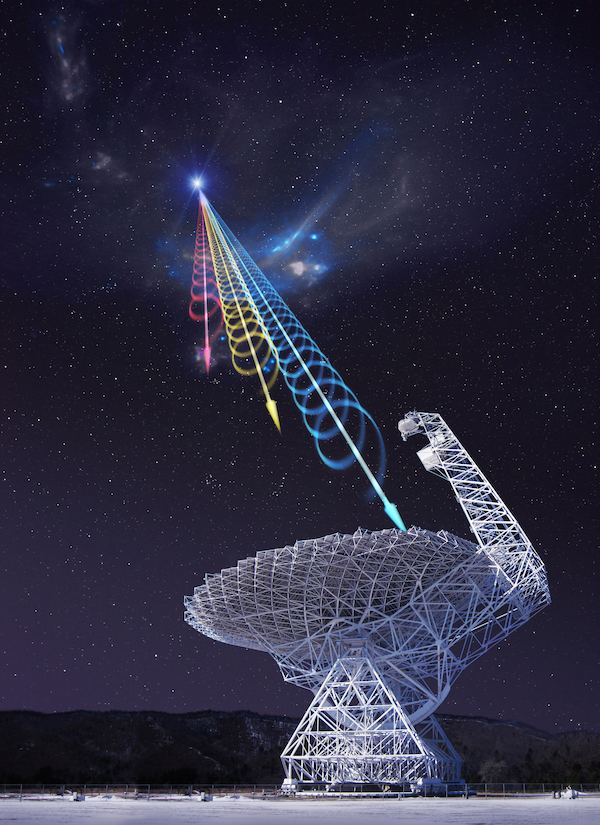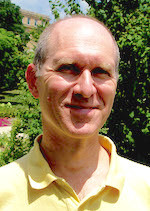Cosmic Radio Bursts yield first clues about their origins

An artist’s rendering of a Fast Radio Burst arriving at the Green Bank Telescope. Fast Radio Bursts are brief and highly energetic pulses of radio waves from the distant universe. Recent research suggests the bursts originate in deep space near what may be a supernova remnant or a stellar nursery.
Image: Jingchuan Yu, Beijing Planetarium
With the help of the world’s largest steerable radio telescope, a team of researchers that includes a University of Wisconsin–Madison physicist has produced the first detailed portrait of a Fast Radio Burst — a brief but highly energetic pulse of radio waves from unknown sources in the distant universe.
First detected about a decade ago, Fast Radio Bursts pack more energy than our sun emits over hundreds of thousands of years. So far, astrophysicists have conclusively detected only 15 such events. What causes the bursts is a mystery.
But now, with the help of hundreds of hours of archived data from the National Science Foundation’s Green Bank Telescope, researchers have pieced together the first detailed picture of a Fast Radio Burst, indicating it originated inside a highly magnetized region of space dense with matter, possibly as a supernova remnant or the energetic environment of a stellar nursery.

Peter Timbie
The new study is reported today (Dec. 2, 2015) in the journal Nature.
“Nobody really knows what these things are,” explains Peter Timbie, a University of Wisconsin–Madison professor of physics and a co-author of the new report.
According to Timbie, whose archived data from the Green Bank Telescope was used to help inform the study, astrophysicists now think that Fast Radio Bursts occur far more frequently than the scant evidence of their existence suggests, with detectable events possibly occurring thousands of times a day.
The reason they weren’t detected in the volumes of data captured each day by the world’s radio telescopes is that there was no specific algorithm for sorting the objects in the data from the many different types of phenomena radio astronomers are looking for. Using new software of their own design, Kiyoshi Masui of the University of British Columbia and his colleague Jonathan Sievers of the University of KwaZulu-Natal in Durban, South Africa, identified a new Fast Radio Burst, named FRB 110523, from data first obtained and archived by Timbie and his Wisconsin colleague Christopher J. Anderson, as well as other radio astronomers.
Timbie and Anderson work as part of a group attempting to sketch out the large-scale structure of the universe by three-dimensionally mapping the distribution of neutral hydrogen atoms in space. Some of their work depends on radio telescope observations such as those made at the Green Bank observatory.
Fast Radio Bursts pack more energy than our sun emits over hundreds of thousands of years.
Masui and Sievers mined nearly 700 hours or archived data, identified the new Fast Radio Burst, and provided the most detailed record to date of a Fast Radio Burst, this one originating an estimated 6 billion light years from Earth.
“It was in the data, but we didn’t notice it,” says Timbie, explaining that the Fast Radio Burst flashes only briefly in a large volume of data and that as radio signals travel cosmological distances they are “smeared out.” Thus, the short, sharp signal of a Fast Radio Burst can be hiding in plain sight.
The new data analysis software, notes Timbie, not only promises to make the discovery of Fast Radio Bursts a much more common occurrence, but is likely to continue to demystify objects astronomers have puzzled over for a decade.
“We now have more information about the source than previous measurements,” Timbie observes. “Because of the nature of the pulse, we can say that it is in an environment where there is a lot of matter.”
Such environments are consistent with things like supernova remnants or stellar nurseries, where dense concentrations of matter are continuously churned into new stars.



